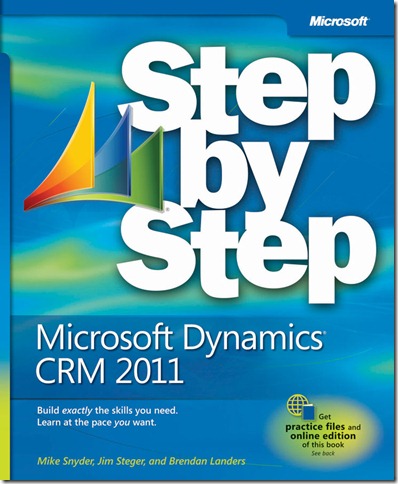RTM’d today: Microsoft Dynamics CRM 2011 Step by Step
 We’re very happy to announce that Microsoft Dynamics CRM 2011 Step by Step, by Mike Snyder, Jim Steger, and Brendan Landers, has shipped to the printer.
We’re very happy to announce that Microsoft Dynamics CRM 2011 Step by Step, by Mike Snyder, Jim Steger, and Brendan Landers, has shipped to the printer.
This book will be available for purchase soon. For now, here’s a list of the contents and an excerpt from the book’s Introduction.
Contents
Part 1 Overview
1 Introduction to Microsoft Dynamics CRM
2 Getting Around in Microsoft Dynamics CRM
3 Working with Accounts and Contacts
4 Working with Activities and Notes
5 Using Microsoft Dynamics CRM for Outlook
Part 2 Sales and Marketing
6 Working with Leads and Opportunities
7 Using Marketing Lists
8 Managing Campaigns and Quick Campaigns
9 Working with Campaign Activities and Responses
Part 3 Service
10 Tracking Service Requests
11 Using the Knowledge Base
12 Working with Contracts and Queues
Part 4 Reporting and Analysis
13 Working with Filters and Charts
14 Using Dashboards
15 Using the Report Wizard
16 Using Advanced Find
17 Reporting with Excel
Part 5 Data Management
18 Bulk Data Importing
Introduction
Welcome to Microsoft Dynamics CRM 2011 Step by Step! Most likely, your organization
has implemented—or is considering implementing—a Microsoft Dynamics CRM system,
and you’re ready to learn more about what the software can do.
Whether you’re a sales associate following up with your top accounts, a marketing professional
reaching out to prospects and customers, a customer service representative resolving customer
requests and issues, or an executive manager seeking to analyze and understand all of your
organization’s customer interactions, Microsoft Dynamics CRM can help you do business better.
The intent of this book is to show you how to use key features in the software to understand
your customers better, increase sales and productivity, and improve customer satisfaction.
It’s important to note that Microsoft Dynamics CRM allows administrators to easily customize
the forms, fields, and other options in the software, so some of the names used in this book
might not match your environment.
A Word About Sandbox Environments
If possible, ask your system administrator about setting up a second Microsoft Dynamics
CRM environment—often referred to as a “sandbox environment”—that you can use
to step through the exercises in this book. A sandbox environment allows you to modify
records without affecting the data in your live system. Your organization might already
have a staging or test environment you can use.
About the Examples in This Book
The descriptions and procedures in this book are based on the default forms and views
in Microsoft Dynamics CRM. As you’ll learn in the chapters that follow, the software also
offers several access options: CRM data can be accessed from a Windows Internet Explorer
web browser, from Microsoft Outlook by using the Microsoft Dynamics CRM for Outlook
feature, or from a mobile device such as a cell phone. Most of the screen shots and examples
in this book show the web browser option.
Just like some of the forms, fields, and data described in this book, the security roles
referenced throughout this book also might have been modified in or even removed
from your system. If you do not have the access needed to view or assign security
roles, talk to your system administrator about setting up a few roles for testing. For
the purposes of this book, we assume that the default roles included with Microsoft
Dynamics CRM have not been modified.
Looking Forward
Microsoft Dynamics CRM is a fluid system that can adapt as your business grows and
changes. By using the step-by-step processes laid out in these pages, you can explore
whatever options you need to match the software with your requirements. We hope
you find this book useful and informative as your organization moves into the future!